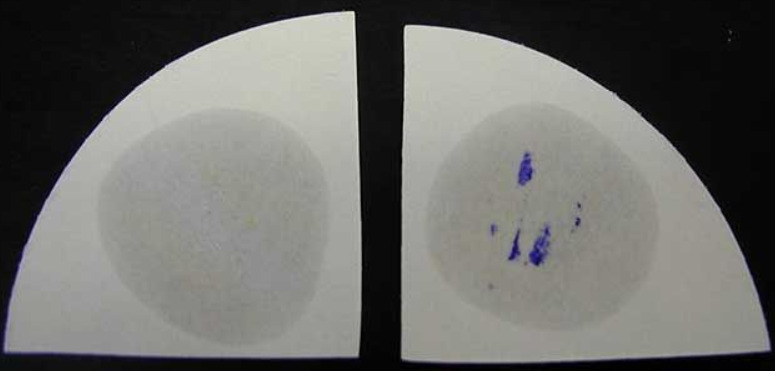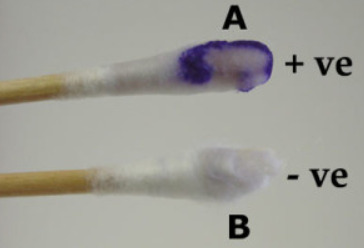Oxidase Test
Last reviewed by Editorial Team on February 27th, 2019.
What is an oxidase test?
It is one of the procedures used to identify a certain strain of bacteria. It identifies bacteria that produce cytochrome c oxidase; a bacterial electron transport chain enzyme.
You will know if the bacteria is oxidase positive or negative by looking at the changes in the color of the reagent. An oxidase test is positive if the color of the reagent changes to purple.
If no oxidase is detected, then the color of the reagent remains the same which is colorless. (1, 2)
What is the purpose of the oxidase test?
- It is used to detect if the microorganism has a cytochrome oxidase enzyme.
- It is helpful in differentiating oxidase positive bacteria like Neisseria, Campylobacter, Moraxella, and Pasteurella species.
- It helps in differentiating pseudomonas from other related species. (1, 2, 3)
What is the principle?
A cytochrome is an iron that contains hemoproteins, which acts as a link in the chain of aerobic respiration transferring electrons to oxygen to form water.
A cytochrome system is aerobic, facultative anaerobic, and microaerophilic organisms.
There are various reagents that can be used in oxidase test.
- Kovacs oxidase reagent
- Gordon and McLeod’s Reagent
- Gaby and Hadley (indophenol oxidase) Reagent (3, 4)
Oxidase Test Procedure
The oxidase test can be performed using various techniques. The most common ones are as follows:

Image 1: An oxidase test using the wet filter paper method.
Picture Source: i.pinimg.com
#1 – Wet Filter Paper Method
- Get a filter paper and soak in a reagent of your choice (choose among the reagent mentioned above).
- Moisten the filter paper using a sterile distilled water.
- Using a wooden or platinum loop, pick a colony of bacteria to be tested and smear in the moistened filter paper.
- Carefully observe for changes in the color. If the color changes to purple or deep blue in just a few seconds, then the result is positive. If no changes in the color, the result is negative. (4, 5)

Picture 2: An oxidase test using the direct plate method.
Photo Source: microbiologyinfo.com
#2 – Direct Plate Method
- Choose a reagent of your choice and apply 2 to 3 drops of reagent to the colony of microorganism on the agar plate. Make sure you apply just enough reagent so as not to flood the plate.
- Make sure you carry out the test on a non-selective agar plate.
- Thoroughly observe for changes in the color within 10 seconds. (5, 6)

Photo 3: An oxidase test using the swab method.
Image Source: microbiologyinfo.com
#3 – Swab Method
- Dip the swab into the reagent and touch the isolated suspect colony of microorganism
- Watch out for changes in the color. If the test is positive, you will see changes in the color in just 10 seconds. (6, 7, 8)
#4 – Test Tube Method
- A fresh culture of bacteria (grow within 24 hours) in placed in a 4.5 ml of nutrient broth.
- A Gaby and Hadley reagent is added (0.2 ml).
- Gently and thoroughly shake to make sure that there is a thorough oxygenation of the culture.
- Watch out for any changes in the color. A change in color within 15 to 30 seconds indicates a positive oxidase test. If no changes in the color, it means that the result is negative. (6, 7, 8)
Oxidase Test Results
- Oxidase positive – Bacteria that are positive for oxidase test are aerobic. They use oxygen as a terminal electron acceptor during respiration.
- Oxidase negative – Bacteria that test negative for oxidase can be aerobic, anaerobic, or facultative. These microorganisms do not contain cytochrome c oxidase. (8, 9, 10)
Examples of oxidase positive microorganisms
- Neisseria
- Pseudomonas
- Vibrio cholera
- Campylobacter spp
- Helicobacter spp/ Haemophilus spp
- Alcaligens
- Aeromonas spp (9)
- Brucella
- Pasturella (7)
- Kingela
- Eikenella
- Moraxella
- Legionella
- Chromobacter (2)
Examples of oxidase negative microorganisms
- Enterobacteriaceae
- Staphylococci
- Streptococci
- Acinetobacter (10)
Are there any limitations?
- It is important to use a fresh reagent (not older than one week) as old reagent auto-oxidizes leading to a false result.
- Test the colony of bacteria on a medium that does not contain too much sugar as bacteria and yeast grow on a medium that has too much concentration of sugar.
- A microorganism that grows on media that contains dyes may lead to a false result.
- Sub-culturing should be done first before adding a reagent to the active culture. Failure to do sub-culturing will kill the microorganism.
- An oxidase positive microorganism should undergo gram staining to find out its morphology and gram reaction. Additional tests should be performed to completely identify the microorganism.
- Avoid using nickel-base alloy wire as it may contain iron and chromium. These substances may lead to a false positive result.
- Timing is important. Make sure you interpret the result within 10 to 15 seconds.
- When performing the oxidase test, you should use a medium that does not have fermentable sugar as the fermented sugar could lead to acidification of the medium, which leads to a false negative result. (2, 6, 9, 10)
An oxidase test is a biochemical test used for identifying strains of bacteria. The test can be done using various methods namely the wet filter method, direct plate method, the swab method, and test tube method.
References:
- https://microbeonline.com/oxidase-test-principle-procedure-and-oxidase-positive-organisms/
- https://en.wikipedia.org/wiki/Oxidase_test
- https://microbiologyinfo.com/oxidase-test-principle-uses-procedure-types-result-interpretation-examples-and-limitations/
- https://microbenotes.com/oxidase-test-principle-procedure-and-results/
- http://www.asmscience.org/content/education/protocol/protocol.3229
- http://spot.pcc.edu/~jvolpe/b/bi234/lab/differentialTests/oxidase_test.htm
- https://www.slideshare.net/drmalathi13/oxidase-test
- http://www.vumicro.com/vumie/help/VUMICRO/Oxidase_Test.htm
- http://www.bio-rad.com/en-uy/sku/3553834-oxidase-test?ID=3553834
- https://www.ncbi.nlm.nih.gov/pmc/articles/PMC291174/
Similar Posts:
- Indole Test
- Catalase Test
- Benedict’s Test
- IMViC Test
- What is Gram Stain Test – Staining Procedure, Principle and Results
